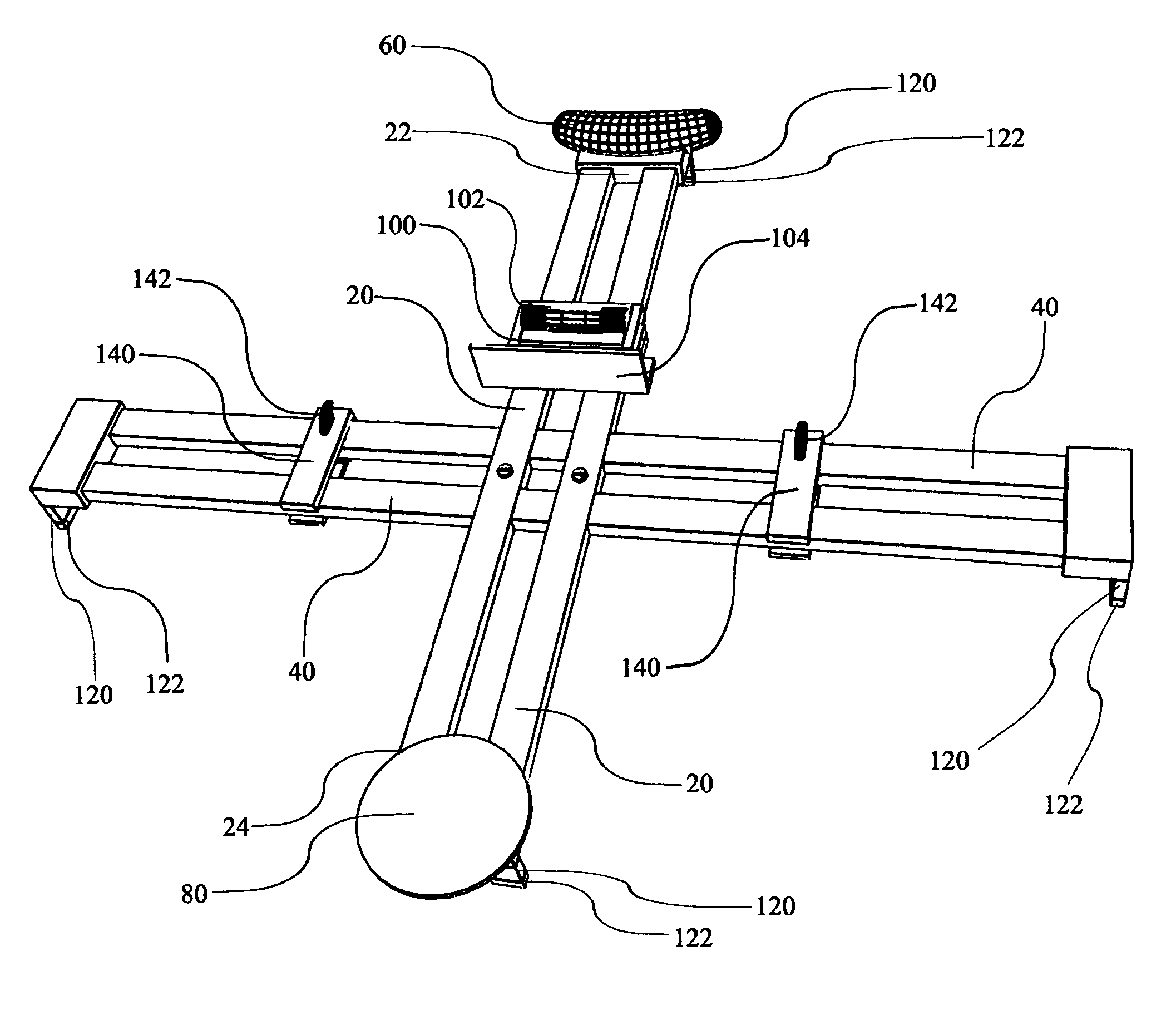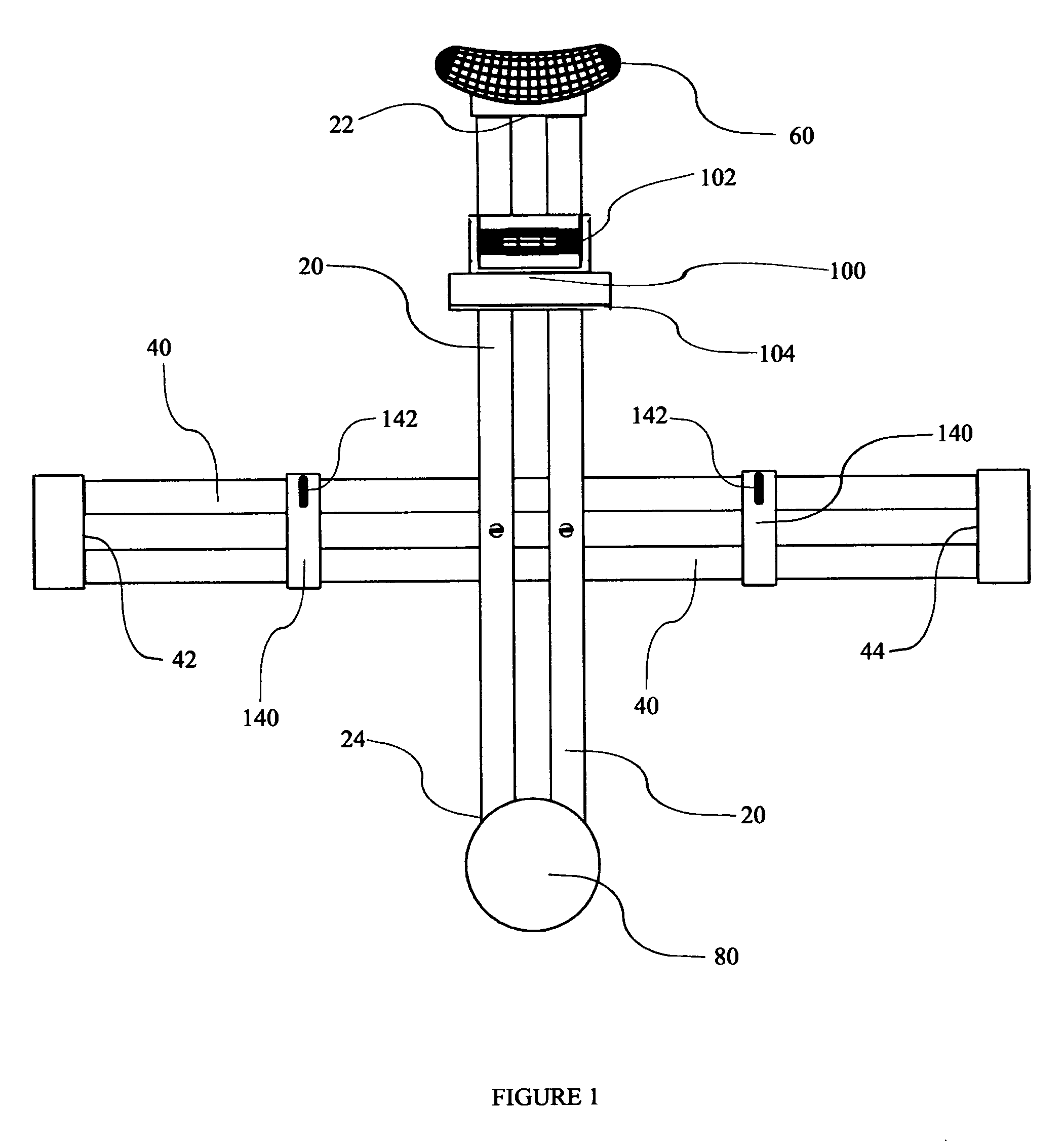However, the Hindall disclosure does not provide a method for hanging heavier pictures requiring more than one hook.
However the Kelly device does not provide a
single step for positioning a picture on the wall and marking the position where a user wants it hung.
The Rimback device addresses and overcomes some of the problems with prior art picture hangers, but is deficient in many other ways, including the hanging of other types of decorative and functional wall items.
The main problems with conventional picture hanging devices are that they are primarily for hanging pictures and are deficient in the area of hanging other two-hook items such as wall sconces, decorative shelves, mirrors, clocks, and pictures with integral mounting holes or mounting clips of differing widths.
While the Rimback device will allow for the hanging of items needing one or two wall hooks, an important limitation of the Rimback device is that its alignment hooks and marking holes are in fixed, pre-determined and non-adjustable positions.
Consequently the Rimback device does not lend itself well to the vast variance of widths found between mounting holes and mounting clips on items intended for wall mounting, such as but not limited to wall sconces, decorative shelves, mirrors and some pictures.
Because of this, the Rimback device and others like it are limited primarily to hanging wire mounted pictures, wherein the spacing or width between the placement of the wall hooks is not critical to hanging.
However, items intended for vertical hanging which have two or more integral
fixed position mounting holes or mounting clips are nearly impossible to hang with the Rimback device and other similar prior art devices, to include decorative items designed to be wall-mounted that are “one-of-a-kind” works of decorative art when it comes to mounting them.
For although several of theses “one-of-a-kind” works may appear to be duplicates of one another, or near duplicates, from the front, each is produced without the precision of
automation and consequently has integral mounting holes or mounting clips that vary widely in spacing and frequently are out of alignment with each other.
As a result,
fixed width, non-adjustable hanging devices, such as the Rimback and similar prior art hanging devices, can not be used effectively to hang such “one-of-a-kind” items, as their non-adjustable
fixed width mounting capability can not accommodate the vast variations in mounting hole or mounting clip widths existing in a wide array of decorative and functional wall items.
Another problem with conventional picture hanging devices is that the integral mounting holes or mounting clips on many hand made wall sconces, decorative shelves, mirrors, pictures, and other items are markedly out of alignment relative to each other and, in a similar manner to the “one-of-a-kind” items mentioned above, and use of level markings on a wall for placement of wall hooks to hang them will not result in a wall-mounted item with a level appearance.
This variation in alignment makes it highly improbable that an installer using any of the currently available hanging devices will be able to mark a wall for hook placement so that unique decorative items can be hung level without having to make at east one surplus hole in the wall.
Another problem with conventional picture hanging devices is that they often damage, mark or scrape the wall around a targeted hanging location as they are being used to position a picture.
This is because they provide no mechanism or means to hold the picture away from the wall prior to and after wall marking, or prevent the edges of the picture or the apparatus itself from contacting the wall while it is being used.
While known prior art devices may be suitable for the particular purpose they address, they are not generally as versatile as the present invention, which allows easy positioning and time-saving leveling, marking and hanging of all types of pictures, sconces, decorative shelves, artwork, clocks, mirrors and other devices from a vertically extending surface.
The main problem with known picture hanging devices is that they are primarily effective for hanging pictures on a wall from a single hook and typically deficient in the area of hanging items requiring two wall hooks, particularly wall sconces, decorative shelves, mirrors, artwork, and pictures with integral mounting holes or mounting clips having differing spaced-apart widths.
Although the Rimback and other similar devices will allow for the hanging of items with one or two hooks, they are significantly limited by their alignment hooks and marking holes being in fixed, non-adjustable positions.
Because of this, the Rimback and other similar hanging devices are limited primarily to hanging wire mounted pictures, since with wire mounted pictures the spacing or width between the placement of the wall hooks is not critical to hanging.
 Login to View More
Login to View More  Login to View More
Login to View More 


